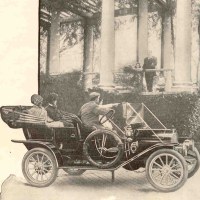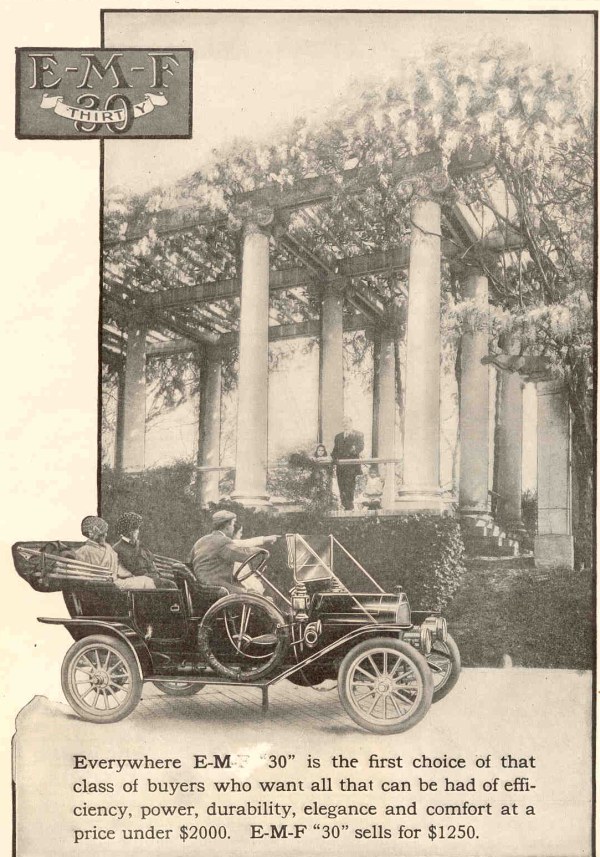 EMF? What was that? Who was that? A TV network? Some old-timers may recall many forgotten makes like Packard, Hudson, Duesenberg, Nash, even Hupmobile and Locomobile. But chances are nobody recalls EMF. That’s kind of strange, because it was larger in its time than any of those.
EMF? What was that? Who was that? A TV network? Some old-timers may recall many forgotten makes like Packard, Hudson, Duesenberg, Nash, even Hupmobile and Locomobile. But chances are nobody recalls EMF. That’s kind of strange, because it was larger in its time than any of those.
Why is EMF so unknown, then?
The birth of the automobile industry was a particularly interesting time. Car companies sprang up like mushrooms in an outhouse replaced by the newfangled invention which killed it: indoor plumbing. Most automotive mushrooms disappeared within a year or two.
The EMF (or E-M-F) Company was actually not one of them. It lasted well into most of our lifetimes.
Intrigued? You should be. 🙂
The letters EMF belong to the three founders: Barney Everitt, Bill Metger and Walter Flanders. (Interestingly, the sequence is the exact opposite of their importance.)
Barney Everitt is the least known of the EMF trio, but he was the one who put it together and carried the title of President. A body builder (two words), he supplied bodies to Olds, Ford and a few of the other early startups. He ended up as the president of the Wayne Automotive Company, one of the increasing number of startups making cars in Detroit. The company lost money and the board believed the high cost of production was the problem, so they hired Walter Flanders, then Ford’s works manager.
Walter Flanders, about ten years younger than Billy, was a big guy in the industry, as well as in stature: 6’3″ with broad shoulders, a mop of curly hair and a booming voice men could hear over roaring machinery. It was a voice he loved–modesty was never one of his weaknesses.
He cut his automotive teeth with Henry Ford, where he quickly became a jack of all trades and the point man for the evolution of Ford’s famous moving mass production line. Until his friend Everitt persuaded him to solve Wayne’s problems.
Bill Metzger was one of the true pioneers of the American automobile industry. He capitalized on the bicycle craze of the late 1800s with Detroit’s largest bicycle shop. He was one of the earliest believers in the automobile and organized America’s first automobile show in Detroit, and then helped organize the first New York Automobile Show, which would become the nation’s most prominent. He was one of the founders of the Northern Motor Car Company.
After Henry Leland helped turn Ford’s second automobile company into Cadillac, they hired Metzger away from Northern to be their sales manager. He used his contacts with the New York Auto Show to get two Cadillacs prominently displayed, from which he brought back over two thousand orders. Thanks to Metzger, Cadillac became the second company to make and sell more than a thousand cars a year.
Metzger became a victim of his own success. The pressure of making so many cars so suddenly put a strain on Cadillac and its president stepped down. The owners persuaded Leland to take over Cadillac and they merged it with Leland’s company. Metzger and Leland didn’t chair each other’s fan clubs and so Metzger began looking for other opportunities, and ended up being the M in EMF.
Launch
EMF was launched in the upscale Café des Beaux Arts in downtown New York City (of which it was famously said ‘it costs real money to dine there’) with a fanfare unlike anything the young industry had ever witnessed. The event was organized by their marketing man, LeRoy Pelletier, so colorful he will merit a post of his own (later).
There was only one problem: they had no product. Staging a jaw-dropping launch party is one thing, designing and tooling up for producing a viable automobile is something entirely different. In modern times the computer industry, known for software and hardware, introduced a new term into our language: vaporware. It means groundbreaking products which get announced and then… nothing.
Not only did EMF not have a product, they didn’t even have a company. It wasn’t until two full months after the party that the EMF Company was incorporated.
Despite no product and no company the brash team announced that in their first year they will produce 12,500 cars, more than anybody else. (Ford claimed he sold more than 10,000 in 1908, but many people thought that number contained a little fudge.) If anybody could pull that feat off, it was Walter Flanders. They had the Wayne factory, and they were in negotiations to add that of Northern, another Detroit car maker (which Metzger called home).
Not only did EMF have no company and no car, it didn’t have any dealers, certainly nothing like the networks sported by Buick, Ford, Cadillac and the other (real) volume producers.
But suddenly a solution appeared on the horizon.
Studebaker
The Studebakers were an Amish family who settled in South Bend, Indiana and became wagon makers. So good was their quality they became the world’s largest wagon maker measured in dollar revenue. (In units sold Durant-Dort had them beat because their products were at the low end of the spectrum… code for cheap.) The U.S. Army and even the mighty British Army relied on Studebaker wagons to transport provisions to battle fronts. Reputable companies with blue chip customer lists, stable managements and steady growth, that’s what J. P. Morgan loved, and they bought a share of Studebaker.
The advent of the automobile in the late 1800s changed everything. J. M. Studebaker was the family patriarch at the time. His daughter married a Wall Street lawyer named Fred Fish, who began working for the company. The Post Office, one of their largest customers, indicated they wanted to switch from horse power (two words) to horsepower (one word). Fish wanted to dive into autos but the old man refused to set aside capital to invest in the venture. Too risky. He and Morgan were birds of a feather.
Fish tried to buy engines from Henry Leland, who supplied both Olds and Cadillac, but failed when Cadillac renewed their order. So he went fishing (no pun intended) for another car company. When he read about EMF’s creation, he jumped. He approached them with an offer to buy their entire output.
That left Metzger, super salesman, with nothing to do, so he and Everitt split. Studebaker bought their shares.
The Squeeze
Fred Fish decided to apply some Wall Street muscle. Once EMF was committed to sell only to Studebaker, Fish stopped ordering. His logic was brutal, but simple: Studebaker had plenty of other products to sell, so they didn’t need EMF product to survive.
EMF was a different story. Flanders, trusting Fish, had put all EMF’s eggs in the Studebaker basket. The contract didn’t allow them to sell to anybody else. Fish knew EMF didn’t have a lot of money, so it would take two, maybe three months before they went bankrupt, at which time Studebaker could pick them up cheaply and Fish could bask in the accolades and the profits.
Sounds good on paper, doesn’t it? (If you’re a fan of unethical Wall Street moves.) Fish, however, didn’t reckon with Walter Flanders. If there was intimidating to be done, Flanders reasoned, it would be he Fish and not Fish him. He summarily announced the contract void because of Studebaker’s non-performance. The next day he placed ads in newspapers across the nation, looking for dealers. At the time, EMF-Studebaker was number 4 behind Ford, Buick and Maxwell-Briscoe, so every dealer worth his salt jumped at this unforeseen, certainly not be repeated, opportunity. Every train ticket into Detroit and and every hotel room sold out in a snap. Everyone talked about it.
In less than two weeks, EMF had a new dealer network. Flanders and Pelletier, not the shy wallflowers of the industry, made sure everyone and his dog knew Fish’s scheme had blown up in his face.
Fish responded with the lawyer knee-jerk. He sued. Early and often–any court which would take the suit. He demanded EMF rescind the new dealer agreements because Studebaker had an exclusive with EMF. Most judges took one look at the case and threw it out because it was Fish, not Flanders, who broke the contract. However, there were a few judges not familiar with the infant automobile industry and who were impressed by the Morgan and Studebaker names. However, once the actual details came to light Fish lost those cases, too.
The End
The upstart Flanders humiliated Studebaker and, by association, J. P. Morgan. Fred Fish and George Perkins, the partner at J. P. Morgan, decided to end the humiliation the classic Morgan way. They overpaid Flanders for his EMF stock and so papered over the problem. Pierpont Morgan was not pleased. He had invested in a staid wagon maker but history turned it into yet another player in the industry he despised.
Flanders stayed on for a while, but started his own car company. The used that to rescue U. S. Motors and turn it into the Maxwell Corporation Walter Chrysler took over and morphed into Chrysler.
When Pierpont Morgan, in Europe chasing art for his collection, heard the terms of the EMF buyout, he was furious and ordered Studebaker to find another backer. Perkins was gone by the end of the year.
Studebaker, made up of the EMF manufacturing operations and the Studebaker dealer network, migrated to another of Fish’s Wall Street contacts, Henry Goldman. Goldman, Sachs and Lehman Brothers recapitalized Studebaker, took out the Morgan interest, and made Studebaker the second automobile company (after General Motors) to be listed on the New York Stock Exchange.
My husband often works night shifts, and even being very tired after a sleepless night, he can’t fall asleep in the daytime. Our GP offered to try Ambien. My husband takes a 10 mg pill and can have a rest after hard work at night. Luckily, there have never been any unwanted reactions to ambien. I think it will be useful for many people working night shifts.
So to answer the original question–why nobody remembers EMF–lies in the fact that Studebaker simply renamed it and buried the name. Still, there was a time when everyone knew who EMF was…
